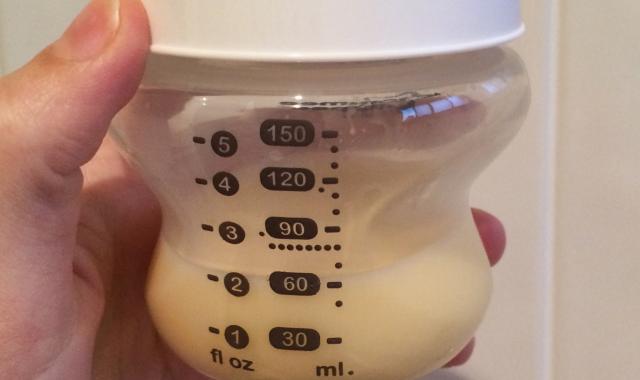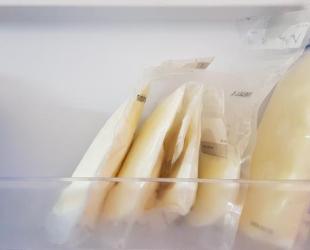New to expressing or wondering if it's the right option for you?

Mums express breastmilk in many different ways and for many different reasons. Milk can be removed by hand or using a manual or electric breast pump.
Learn the basics of how, when and why you might choose to express your breastmilk.
Reasons for expressing
You might express because:
- Your baby is premature or unable to suck well
- You or your baby are in hospital and you can't be together for every feed
- You're planning to go back to work
- Someone else is caring for your baby while you are out
- Your breasts sometimes feel too full and uncomfortable
- You want to have a store of breastmilk in the freezer for emergencies
- You are trying to increase your milk supply
- You want to relactate or induce lactation
Expressing isn't always the best or only option
There are some important things to think about when deciding if expressing is right for you.
- Expressing isn’t always needed. Many breastfeeding mums never need to express and their babies never need expressed breastmilk. They find that breastfeeding fits in with their daily lives including social activities, work and study.
- Expressing takes time and energy. It can be hard to find the time to express when you are caring for a young baby. If you use a breast pump it takes extra time to set-up and clean the equipment.
- It can increase your supply unnecessarily. Removing more milk than your baby needs each day can create an oversupply. This can increase your risk of breast inflammation.
- It takes practice. It can take time to learn how to hand express or use a breast pump. A few mums find it difficult to express any milk even though they have a good supply and their baby is growing well.
- Expressing won’t fix any underlying problems. Some mums think about expressing because breastfeeding isn’t going well. Getting help and support with any breastfeeding problems may be a better long-term fix.
Depending on your reasons for expressing, there may be other more helpful options available to you. Speak to an ABA breastfeeding counsellor to work out a plan for your situation. If you decide to express, you might wonder about the following questions.
Your expressing questions answered
How often you need to express depends on why you’re doing it and whether your baby is also having some feeds at the breast. If you are exclusively expressing milk to feed your baby you should aim to express your breasts fully, as often as your baby would normally breastfeed. This will depend on their age. Whatever age your baby is, the more milk you take out of your breasts, the more milk you will make.
I’m expressing for a newborn baby
Try to express often (at least 8 times in 24 hours). At first, you may find it easier to pump for shorter periods but more often. Many mums find a routine of expressing every 2 to 3 hours during the day, with a session just before going to bed, works for them.
Try to avoid any long gaps (more than 6 hours) between expressing sessions while you are building up your milk supply.1 This means you may need to express once or twice at night too. Milk supply and response to expressing vary between mums, so you may have to try different timing to find a pattern that suits you.
Learn more about expressing for your newborn
I want to save up some breastmilk for later
If you are expressing milk to store for later, you may choose to express a little and often to fit around breastfeeds. If your baby has a long gap between feeds, for example during the first part of the night, you may be able to express a little more at that time.
Do I really need a store of frozen milk?
My breasts feel too full and sore
If you are expressing because your breasts are too full, you can do this as needed for comfort. Don’t remove more milk than you need to though, or your breasts will continue to make more.
Mums vary in the amount of time it takes them to express. The length of time depends on many factors (time of the day, technique used, pump type and setting, and your flow rate). The number of times you express during the day is often more important than the length of time you spend expressing.
It can take a minute or two for the milk to begin flowing freely, or 'let down', when you express. If you can touch, see or hear your baby this may help. There are also extra steps you can try when expressing to help the milk to flow.
An expressing session usually goes for about 15 to 20 minutes, or until milk no longer flows out but just drips. Keep going for a few minutes past when your milk stops flowing, as this might trigger another let-down. Some may need a little more or a little less time. But for most mums, pumping for more than 30 minutes is too long.
This depends on your reason for expressing. If you are exclusively expressing for all your baby's feeds you will need to express more milk than a mum who is just expressing for the occasional feed when she is away from her baby. Take care not to create an oversupply by expressing more milk than needed. This is especially true in the early weeks while your supply is settling to match your baby's needs.
Research tells us that breastfed babies between 1 and 6 months of age take an average of 800 mL per day, although some may need less and some more.2 You can use this amount as a guide to help you know how much you may need to express and leave for your baby:
- To work out the volume of a single feed, divide 800 mL by the number of feeds your baby usually has in 24 hours.
- Multiply this amount by the number of breastfeeds you will be missing.
As an example, if your baby has 10 feeds in 24 hours, then 800 mL divided by 10 equals 80 mL per feed. If you think they will miss 3 breastfeeds while you are away, the total amount of milk you leave will need to be 3 x 80 mL, which is 240 mL.
It’s helpful to store your milk in several smaller containers so it isn’t wasted. The amount of milk your baby wants may vary from day to day. A few extra small amounts of frozen expressed breastmilk (40 to 60 mL) left with your baby’s carer will allow for these changes and avoid wasting a full feed.
Some mums who are expressing regularly can quickly get a large amount of breastmilk from each breast. Other mums simply can’t get a lot at one time, and find it easier to express small amounts more frequently (eg up to 30 mL every 1-2 hours).
It’s important not to judge how much milk you are making by the amount of milk you can express. Pumping and hand expressing are skills that can take time to learn. If your baby is feeding well, they will take more milk from your breast, and more quickly, than you will by pumping or hand expressing.
© Australian Breastfeeding Association March 2024
Lai, C. T., Rea, A., Mitoulas, L. R., Kent, J. C., Simmer, K., Hartmann, P. E., & Geddes, D. (2020). Short-term rate of milk synthesis and expression interval of preterm mothers. Archives of Disease in Childhood. Fetal and Neonatal Edition, 105(3), 266–269.
Rios-Leyvraz, M., & Yao, Q. (2023). The volume of breast milk intake in infants and young children: A systematic review and meta-analysis. Breastfeeding Medicine, 18(3), 188–197.
Kent, J. C., Mitoulas, L. R., Cregan, M. D., Ramsay, D. T., Doherty, D. A., & Hartmann, P. E. (2006). Volume and frequency of breastfeedings and fat content of breast milk throughout the day. Pediatrics, 117(3), e387–e395.
Read more about expressing and storing
Evidence-led info and practical tips from our Breastfeeding Information Series



